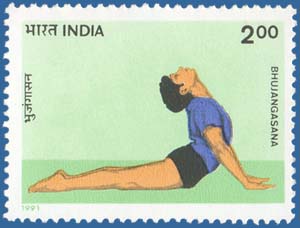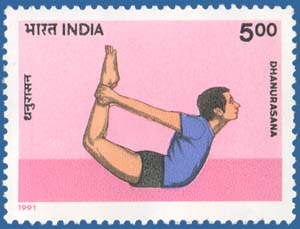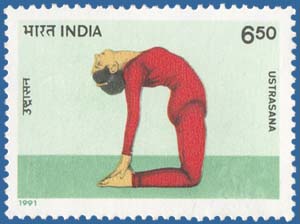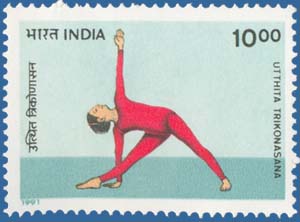
YOGASANA
In Yoga Sutra, Sage Patanjali, the founder of the Yoga school of Philosophy, describes yoga as "the restraint of mental fluctuations". This restraint leads to the goal of yoga-spiritual liberation. To attain this, Patanjali prescribes "Ashtanga-Yoga" or an eight-fold path. Yogasanas are the third aspect of "Ashtanga-Yoga". Yogasanas, practised correctly and diligently, bring about vast physical and psychological changes.
The following four asanas have been depicted on the stamps:

Bhujangasana: This asana adjusts minor displacements of the vertebrae and exercises and tones up the deep muscles supporting the spinal column and the trunk.

Dhanurasana: This asana stretches the entire spinal column, exerts extraordinary intra-abdominal pressure, causes fresh supply of blood to the abdominal viscera, especially to the lower abdomen and gives exercise to the neck, arms, shoulders, back, legs and ankles.

Ustrasana: This asana provides an anterior stretch to the spine, prevents flabbiness and relieves vertebral pressure, promotes spinal circulation and strengthens the urogenital muscles.

Utthita Trikonasana: This asana strengthens the thigh and calf muscles, relieves constipation, indigestion and flatulence and is beneficial for the treatment of lumber spondylitis and obesity.
OTHER ASANAS:
The Padmasana is the classic meditative posture and it offers the maximum fixity of base, preserves normal elasticity and especially helps all the important muscles, ligaments and tendons of the lower extremities and increases blood circulation to the abdomen-genital region.
The Trikonasana increases flexibility of the waist, exercises the hips, stretches the muscles of the arm and legs, strengthens the hamstring muscles and corrects faulty posture habits by intra-abdominal compression.
The Shirshasana strengthens all the body systems - the circulatory, digestive, respiratory, nervous and excretory. It is, however, of greatest benefit to the brain as it helps nourishment to its cells and tissues by reversing the blood supply. It prevents premature greying of the hair and the skin becomes bright and smooth and the face, radiant
The Navasana strengthens the thigh and abdominal muscles, enhances concentration and stability of the mind and is beneficial for diabetic and obese patients.
The Artha Matsyandrasana helps in removing the lateral curvature of the spine, increases venous circulation in the abdominal zone, tones up the liver, spleen and pancreas, promotes gastric secretion and improves the appetite.
The Dhanurasana proves full exercise to the spine, which becomes more elastic. It benefits the kidneys and helps cure abdominal disorders by stretching the entire digestive area. It also provides sufficient exercise to the neck, ribs and lungs, strengthens the heart and removes obesity.
The Urdhva Dhanurasana is especially useful in correcting spinal disorders and is also used in the yogic treatment of asthma and other respiratory diseases.
The Sarvangasana improves circulation to the brain, benefits the glandular system especially the thyroid, bring relief from congestion in the abdominal and pelvic regions and is good for those who are suffering from constipation, dyspepsia and neurasthenia.
Description of designs:
The set of 4 stamps has been designed by India Security Press, Nasik on the basis of material and suggestions provided by Smt. & Shri Rajiv Chanchani. The First Day Cover has been designed by Shri Sankh Samant and shows the four asanas depicted on the stamps. The cancellation which depicts the Dhanurasana has been designed by Ms. Alka Sharma. The drawings of the various asanas shown in the brochure have been done by Shri J. Nath of Kodaikanal.
Date of Issue : 30.12.1991